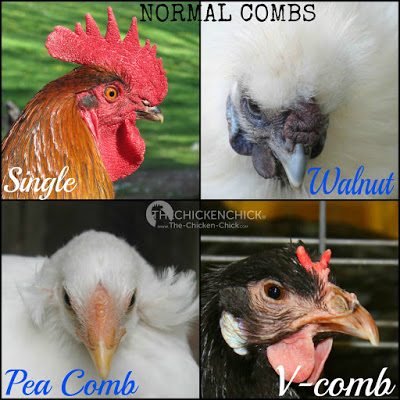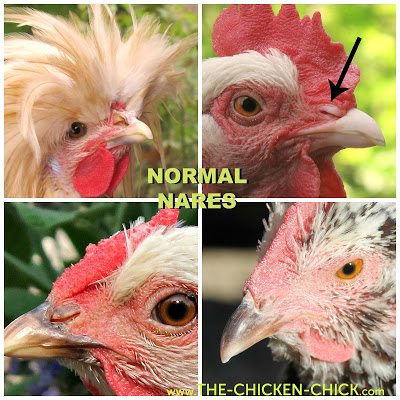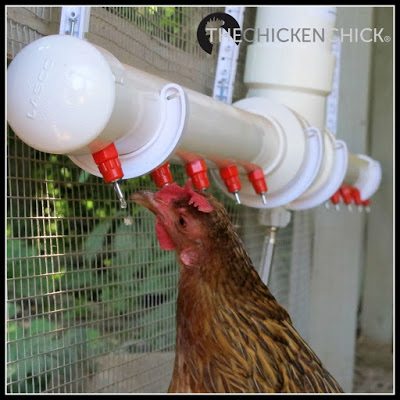Regular physical exams for chickens are important to their health and longevity because they are masterful at hiding pain, discomfort and weakness. Chickens offer subtle clues when they are under the weather and by regularly spending time with our flocks, we can pick up on signs that they are not feeling well. Common indications of a sick chicken include: hiding, inactivity, pale comb or wattles, unusual droppings, unusual posture, lethargy, lack of appetite and reduced egg production- all signals that closer observation is needed and this article covers what to look for from head to toe. ![]()
OVERALL BEHAVIOR & GENERAL APPEARANCE
Any change from normal behavior and appearance should be investigated further. A healthy bird is alert and active, eating and drinking throughout the day with periods of dust bathing, reclining and resting mid-afternoon. A healthy bird should not sit in the same spot for hours at a time or fail to move when approached. They should not limp, have labored breathing, avoid food, drink excessively, lose weight or hide. A sudden drop in egg production should be looked into as egg production is one of the first functions to cease in a sick chicken.
WHEN TO EXAMINE A CHICKEN?
Most chickens don’t care to be handled, so it is easiest to examine a chickens after dark when they’re roosting. I use use a headlamp and bring a partner in crime whenever possible. Bath time is another excellent opportunity to get a closer look; after the initial surprise of being placed into water, most chickens love baths, but they should only be bathed when necessary for reasons discussed here.
If neither of those opportunities is convenient, loosely wrapping a bird in a towel, covering its head and eyes while ensuring ample breathing room keeps a bird immobilized, safe and calm.
POOP
Often the first sign of a health problem will be unusual droppings. Learn to recognize which droppings are normal and which are abnormal. Installing a droppings board underneath the roost provides an opportunity each morning to observe abnormalities unobscured by shavings or other bedding material.


WEIGHT
An adult chicken should maintain a consistent weight. Weight loss may indicate things like illness, worms, coccidiosis, malnutrition and bullying. Weight gain indicates over-feeding, usually by way of treats, snacks and kitchen scraps. Obesity related complications leading to death is a problem of epidemic proportions in backyard pet chickens. This is an affiliate link to the scale I use (shown below).
COMB & WATTLES
The comb and wattles should be red and correct for the breed. If a chicken’s normal comb is usually upright, it shouldn’t be flopped over, if it’s usually full or plump looking, it shouldn’t be shriveled.
The comb and wattles should not be pale, purple, ashy, have lesions or scabs, which could indicate things like fowl pox, frostbite, pecking injuries from other chickens or favus. It can be normal for a broody hen, a molting chicken and a pullet that has not yet begun laying eggs to have a pale comb as shown in the Araucana with the pea comb in the photo above.

EYES
A chicken’s eyes should be clear, bright, round and moist. The pupils should be round and equal in size. The pupils should react to light (constrict and return to normal). The iris (colored portion of the eye) should not be grey. They eyes should not be dry, sunken, swollen, cloudy, watery or crusty; there should be no bubbles or other discharge. Chickens possess a third eyelid, which is normal and generally ruins an otherwise decent photo.
NARES
A chicken’s nostrils are called nares. The nares should be clean and free from discharge or crustiness.
BEAK
A normal beak is smooth, free from cracks and closed most of the time. An open beak can indicate stress or over-heating. The upper mandible (top half of the beak) is slightly longer than the lower and should be aligned directly above it. Any sudden change in alignment is abnormal. Chips, breaks or overgrown beaks should be honed by filing. Scissor beak, also known as crossed beak, is a common deformity that does not occur suddenly.
MOUTH
There should be no foaming or discharge from the mouth. Any noisy, squeaky or labored breathing is abnormal. The inside of the mouth should be free from lumps, lesions and discoloration. Wet fowl pox and mold toxicity are common causes of cheesy-looking lesions inside the mouth. There should be no bad odor coming from the mouth, which could indicate sour crop.


FEATHERS
A chicken’s feathers should be shiny & lay flat against the body. They should not be bloody. Unless the birds are approaching a molt, feathers should not be broken, ruffled, frayed or tattered, which could indicate behavioral problems in the flock, stress, parasites, a nutrition deficit (most often protein)or rodent problems. Know what molting looks like and the age and season to expect it as well as what pin feathers look like. Frizzle feathered breeds are an exception to the flat feather rule.


SKIN
Skin injuries and other abnormalities can be well hidden by feathers. Part feathers all over the chicken’s body to inspect the skin, which should be free from mites, lice, lacerations, lumps, injuries from roosters’ nails during mating, fly larvae/maggots, etc.
BREAST & KEEL
CROP
After a chicken has eaten, the crop feels swollen and slightly firm, but shrinks as food is digested. The crop should be empty first thing in the morning after a night of inactivity. A chicken’s crop should not remain hard, squishy or fluid-filled. Much more about the crop HERE.
WINGS
The bones of a chicken’s wings should be free from cuts, swelling or injuries. The armpit area underneath the wing (wingpit?) should be free from mites and lice.
ABDOMEN
The abdomen should be firm, but not hard, swollen or squishy like a water balloon. An abnormal abdomen finding could mean egg yolk peritonitis, egg binding, salpingitis, ascites, heart failure or a number of other serious issues requiring a veterinarian.
PREEN GLAND, OIL GLAND, UROPYGIAL GLAND
The preen gland should be free from lumps or appear blocked. The skin surrounding the preen gland should be parasite-free.

VENT
The vent should be clean and moist, not wet; there should be no discharge or accumulations on the area surrounding the vent. The shape will look like a vending machine coin slot if a hen is in lay, it will look more like a circle if she is not in lay. The vent should not protrude, be bloody or dry.

LEGS, FEET & TOES
Scales on a chicken’s legs and feet should be smooth and lie flat- they should not be raised, flaky or crusty-looking, which could indicate scaly leg mites. Feet and legs should be free from swelling, lesions, scabs (see bumblefoot infection). Feathered shanks should be checked for broken pin feathers or lacerations. Nails should be reasonable length and trimmed or filed if overgrown.
Once you have some idea about what could possibly be going on with your chicken, visit my Chicken Resources Directory for common chicken ailments and at-home treatments when a veterinarian visit is not an option.
HEALTHY CHICKEN BASICS: KEEP IT SIMPLE!
Do not believe that you must add supplements of any kind to your flock’s feed to keep them healthy! Reputable feed manufacturers employ poultry nutritionists to calculate your chickens’ precise daily needs for a healthy, long, productive life. Tinkering with those calculations by adding supplements, including “natural” ingredients, is unnecessary and can negatively impact their health.
Three ways to ensure the driest environment possible are:
- by employing a droppings board and removing droppings from it daily
- by using sand as coop litter/bedding and as ground cover in the run
- by keeping waterfowl and chickens in different yards (Less moisture results in fewer opportunities for organisms to grow that can make chickens sick.)

Find basic guidelines to follow when caring for a sick chicken without a vet HERE.
RESOURCES Tap into any/all of the state, local and national professional resources listed here as needed.
Sources & further reading:
1 http://www.nutrition-and-you.com/pumpkin.html
2 http://www.motherearthnews.com/eggs.aspx#ixzz2AcKccLNq
3 http://shagbarkbantams.com/de.htm
http://www.poultryhelp.com/toxicplants.html
http://www.exoticpetvet.net/avian/onions.html
http://www.avocado.com/site/fun-facts/avo-info/avocado-toxicity-in-animals-and-pets
http://www.merckvetmanual.com/mvm/index.jsp?cfile=htm/bc/213200.htm (salty foods are acceptable in moderation, occasionally as long as there is plenty of fresh water available, but never salt alone)
http://en.wikipedia.org/wiki/Phytohaemagglutinin
http://www.merckvetmanual.com/mvm/index.jsp?cfile=htm/bc/211102.htm
http://www.peteducation.com/article.cfm?c=15+1912&aid=2236
http://www.ncbi.nlm.nih.gov/pubmed/7255913
Kathy Shea Mormino
Affectionately known internationally as The Chicken Chick®, Kathy Shea Mormino shares a fun-loving, informative style to raising backyard chickens. …Read on


shop my SPONSORS
Regular physical exams for chickens are important to their health and longevity because they are masterful at hiding pain, discomfort and weakness. Chickens offer subtle clues when they are under the weather and by regularly spending time with our flocks, we can pick up on signs that they are not feeling well. Common indications of a sick chicken include: hiding, inactivity, pale comb or wattles, unusual droppings, unusual posture, lethargy, lack of appetite and reduced egg production- all signals that closer observation is needed and this article covers what to look for from head to toe. ![]()
OVERALL BEHAVIOR & GENERAL APPEARANCE
Any change from normal behavior and appearance should be investigated further. A healthy bird is alert and active, eating and drinking throughout the day with periods of dust bathing, reclining and resting mid-afternoon. A healthy bird should not sit in the same spot for hours at a time or fail to move when approached. They should not limp, have labored breathing, avoid food, drink excessively, lose weight or hide. A sudden drop in egg production should be looked into as egg production is one of the first functions to cease in a sick chicken.
WHEN TO EXAMINE A CHICKEN?
Most chickens don’t care to be handled, so it is easiest to examine a chickens after dark when they’re roosting. I use use a headlamp and bring a partner in crime whenever possible. Bath time is another excellent opportunity to get a closer look; after the initial surprise of being placed into water, most chickens love baths, but they should only be bathed when necessary for reasons discussed here.
If neither of those opportunities is convenient, loosely wrapping a bird in a towel, covering its head and eyes while ensuring ample breathing room keeps a bird immobilized, safe and calm.
POOP
Often the first sign of a health problem will be unusual droppings. Learn to recognize which droppings are normal and which are abnormal. Installing a droppings board underneath the roost provides an opportunity each morning to observe abnormalities unobscured by shavings or other bedding material.


WEIGHT
An adult chicken should maintain a consistent weight. Weight loss may indicate things like illness, worms, coccidiosis, malnutrition and bullying. Weight gain indicates over-feeding, usually by way of treats, snacks and kitchen scraps. Obesity related complications leading to death is a problem of epidemic proportions in backyard pet chickens. This is an affiliate link to the scale I use (shown below).
COMB & WATTLES
The comb and wattles should be red and correct for the breed. If a chicken’s normal comb is usually upright, it shouldn’t be flopped over, if it’s usually full or plump looking, it shouldn’t be shriveled.
The comb and wattles should not be pale, purple, ashy, have lesions or scabs, which could indicate things like fowl pox, frostbite, pecking injuries from other chickens or favus. It can be normal for a broody hen, a molting chicken and a pullet that has not yet begun laying eggs to have a pale comb as shown in the Araucana with the pea comb in the photo above.

EYES
A chicken’s eyes should be clear, bright, round and moist. The pupils should be round and equal in size. The pupils should react to light (constrict and return to normal). The iris (colored portion of the eye) should not be grey. They eyes should not be dry, sunken, swollen, cloudy, watery or crusty; there should be no bubbles or other discharge. Chickens possess a third eyelid, which is normal and generally ruins an otherwise decent photo.
NARES
A chicken’s nostrils are called nares. The nares should be clean and free from discharge or crustiness.
BEAK
A normal beak is smooth, free from cracks and closed most of the time. An open beak can indicate stress or over-heating. The upper mandible (top half of the beak) is slightly longer than the lower and should be aligned directly above it. Any sudden change in alignment is abnormal. Chips, breaks or overgrown beaks should be honed by filing. Scissor beak, also known as crossed beak, is a common deformity that does not occur suddenly.
MOUTH
There should be no foaming or discharge from the mouth. Any noisy, squeaky or labored breathing is abnormal. The inside of the mouth should be free from lumps, lesions and discoloration. Wet fowl pox and mold toxicity are common causes of cheesy-looking lesions inside the mouth. There should be no bad odor coming from the mouth, which could indicate sour crop.


FEATHERS
A chicken’s feathers should be shiny & lay flat against the body. They should not be bloody. Unless the birds are approaching a molt, feathers should not be broken, ruffled, frayed or tattered, which could indicate behavioral problems in the flock, stress, parasites, a nutrition deficit (most often protein)or rodent problems. Know what molting looks like and the age and season to expect it as well as what pin feathers look like. Frizzle feathered breeds are an exception to the flat feather rule.


SKIN
Skin injuries and other abnormalities can be well hidden by feathers. Part feathers all over the chicken’s body to inspect the skin, which should be free from mites, lice, lacerations, lumps, injuries from roosters’ nails during mating, fly larvae/maggots, etc.
BREAST & KEEL
CROP
After a chicken has eaten, the crop feels swollen and slightly firm, but shrinks as food is digested. The crop should be empty first thing in the morning after a night of inactivity. A chicken’s crop should not remain hard, squishy or fluid-filled. Much more about the crop HERE.
WINGS
The bones of a chicken’s wings should be free from cuts, swelling or injuries. The armpit area underneath the wing (wingpit?) should be free from mites and lice.
ABDOMEN
The abdomen should be firm, but not hard, swollen or squishy like a water balloon. An abnormal abdomen finding could mean egg yolk peritonitis, egg binding, salpingitis, ascites, heart failure or a number of other serious issues requiring a veterinarian.
PREEN GLAND, OIL GLAND, UROPYGIAL GLAND
The preen gland should be free from lumps or appear blocked. The skin surrounding the preen gland should be parasite-free.

VENT
The vent should be clean and moist, not wet; there should be no discharge or accumulations on the area surrounding the vent. The shape will look like a vending machine coin slot if a hen is in lay, it will look more like a circle if she is not in lay. The vent should not protrude, be bloody or dry.

LEGS, FEET & TOES
Scales on a chicken’s legs and feet should be smooth and lie flat- they should not be raised, flaky or crusty-looking, which could indicate scaly leg mites. Feet and legs should be free from swelling, lesions, scabs (see bumblefoot infection). Feathered shanks should be checked for broken pin feathers or lacerations. Nails should be reasonable length and trimmed or filed if overgrown.
Once you have some idea about what could possibly be going on with your chicken, visit my Chicken Resources Directory for common chicken ailments and at-home treatments when a veterinarian visit is not an option.
HEALTHY CHICKEN BASICS: KEEP IT SIMPLE!
Do not believe that you must add supplements of any kind to your flock’s feed to keep them healthy! Reputable feed manufacturers employ poultry nutritionists to calculate your chickens’ precise daily needs for a healthy, long, productive life. Tinkering with those calculations by adding supplements, including “natural” ingredients, is unnecessary and can negatively impact their health.
Three ways to ensure the driest environment possible are:
- by employing a droppings board and removing droppings from it daily
- by using sand as coop litter/bedding and as ground cover in the run
- by keeping waterfowl and chickens in different yards (Less moisture results in fewer opportunities for organisms to grow that can make chickens sick.)

Find basic guidelines to follow when caring for a sick chicken without a vet HERE.
RESOURCES Tap into any/all of the state, local and national professional resources listed here as needed.
Sources & further reading:
1 http://www.nutrition-and-you.com/pumpkin.html
2 http://www.motherearthnews.com/eggs.aspx#ixzz2AcKccLNq
3 http://shagbarkbantams.com/de.htm
http://www.poultryhelp.com/toxicplants.html
http://www.exoticpetvet.net/avian/onions.html
http://www.avocado.com/site/fun-facts/avo-info/avocado-toxicity-in-animals-and-pets
http://www.merckvetmanual.com/mvm/index.jsp?cfile=htm/bc/213200.htm (salty foods are acceptable in moderation, occasionally as long as there is plenty of fresh water available, but never salt alone)
http://en.wikipedia.org/wiki/Phytohaemagglutinin
http://www.merckvetmanual.com/mvm/index.jsp?cfile=htm/bc/211102.htm
http://www.peteducation.com/article.cfm?c=15+1912&aid=2236
http://www.ncbi.nlm.nih.gov/pubmed/7255913







































































I have had hens for a about a year now, and they are great. Today, I had one with a prolapsed vent. After following the advice in your blog and a few other books, she looks good. However, it looked like she vomitted up some water this evening. Her behavior is fairly normal, but I am a little concerned. Do you ever call a vet, and if so, how do you know when to do so?
Planning to start our own backyard flock – hope we don’t have to face too many of these concerns, but good to know where to look for solutions.
Wonderful information! Next project will be to make a waterer with the poultry nipples!
Would love to win this! Shake the container and watch them run for it!
My girls love Chubby Worms